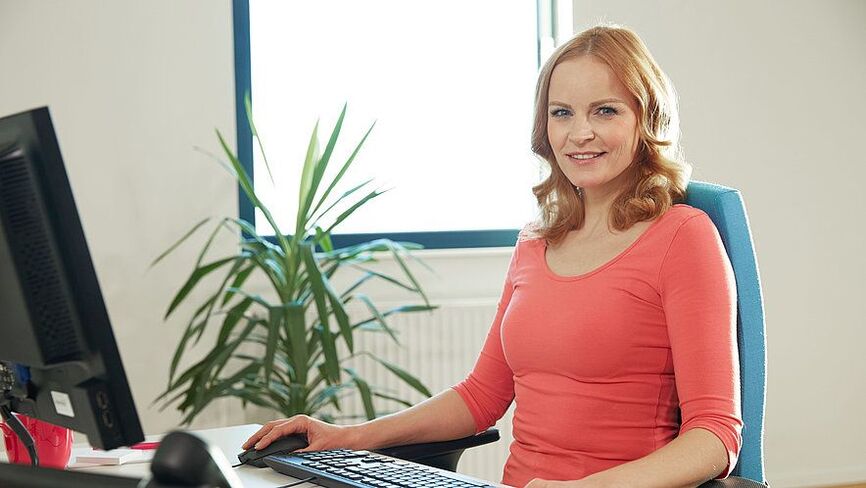Back pain is one of the most common disease complaints of the elderly, the elderly and the elderly. The human spine bears almost the entire weight of a person. It consists of 33-34 vertebrae, which are connected by intervertebral discs. Thanks to this connection, the vertebrae are able to move relative to each other. The sacrum and coccyx are special parts of the spine. The sacrum is formed by five interconnected vertebrae, and the coccyx is the lower part of the spine that does not perform a support function.
Pain can arise in one or all three parts of the spine. Often, pain occurs in the cervical, thoracic and lumbar spine. Pain can be caused by disc disease and injury (disc protrusion, herniated disc) and intervertebral joints (facet joint arthrosis) or other conditions. The number of people experiencing back pain has increased dramatically in recent years and decades, making this complaint the most common in the world.
Kind of back pain
Acute back pain lasts up to six weeks. If it lasts up to 12 weeks, it is called subacute. Pain that persists after 12 weeks is called chronic pain.
Depending on the definition of a particular cause of pain, there are:
- nonspecific back pain;
- certain back pain.
Certain back pain
If the exact cause of the pain is known, it is referred to as specific back pain.
Examples of specific pain include trauma, disc injuries, inflammation of the intervertebral joints (facet arthrosis).
Nonspecific back pain
In some cases, back pain is classified as nonspecific because it is impossible to determine the exact cause.
Nonspecific back pain can occur with poor posture or lack of physical activity.
Symptoms and complaints
Almost everyone suffers from "lumbago" or mild back pain. "Come back again! "- a very common phrase, as the back experiences significant stress every day. Hours are spent sitting in the office, bending over in front of a computer, lifting and carrying heavy objects, or working in the garden with a position: mild back pain is an integral part of everyday life.
Back pain needs to be taken seriously. The reason for going to the doctor is a situation when the pain does not go away for several days, when certain movements increase the pain or when the pain radiates to the limbs, and especially when there is a feeling of numbness.
Shooting pain in the lower leg is characteristic of compression of the spinal cord or its roots (e. g. , a herniated disc). The pain associated with arthritic changes in the intervertebral joints is usually dull and localized. The nature and intensity of pain can vary greatly from person to person. Only a doctor can, based on complaints and symptoms, prescribe the necessary examination and treatment according to the situation. Depending on the situation, the doctor may prescribe physiotherapy, therapy training, or schedule surgery. With conservative treatment and in the postoperative recovery period, it is very important to perform therapeutic exercises on a regular basis, as they train the muscles, stabilize the spine and reduce pain.
The most common cause of back pain
The spinal column or spine is a complex structure consisting of vertebrae, intervertebral discs, and ligaments. Pain occurs when the interaction of these structures is disrupted. Common reasons are:

Stress causes back pain
Inactive work and lack of physical activity in daily life cause chronic tension in the back muscles and pain in the spine in the absence of disease.
The intervertebral disc acts as a biological shock absorber and separates the vertebral bodies from each other. With a decrease in the elasticity of the disc, it begins to surge into the lumen of the spinal canal (called prolapse), and its height decreases. The latter have a negative impact on the work of the intervertebral joints, because their biomechanics are disturbed.
If the protruding part of the intervertebral disc presses on the sensitive nerve fibers, then various sensory disturbances can occur in the nerve zone of compression nerve: pain, tingling, numbness, creeping, etc. If the motor nerve fibers responsible for muscle work are compressed, then the function of the nerve muscles is disrupted, resulting in paralysis.
Postural disorders and weight lifting can lead to disruption of the anatomical contact of spinal structures. In some cases, this results in a so -called intervertebral joint block, usually accompanied by severe pain. When the intervertebral joint is blocked, the back muscles are in a state of painful spasm. Therefore, pain occurs not only in clogged joints, but in muscles. This dramatically reduces the patient’s physical activity to the point of not being able to walk. When blocking the intervertebral joint, effective spinal stabilization with a medi brace helps relieve muscle spasms, localize pain and increase motor activity.
As we age, our spine gradually changes its structure, which is described by the general term "degenerative changes". In this case, the word "degenerative" means irreversible changes as a result of aging. Although the process is irreversible, the use of orthoses helps relieve and improve the patient’s condition.
Degenerative changes in the intervertebral disc indicate a violation of its elasticity, a decrease in height and swelling into the lumen of the spinal canal. A decrease in disc height causes an increase in pressure on the intervertebral joint (facet).
The position of the spine, including the lumbar spine, is stabilized by muscle work. The back muscles, abdominal muscles and lateral abdominal wall muscles are involved in maintaining posture. Muscle work makes the load on the intervertebral disc more even and prevents excessive stretching of the tendon-ligament apparatus. Any pain syndrome has a negative impact on muscle function, which can lead to local hypertonicity or, conversely, local weakness. As a result, spinal stabilization is impaired. This, in turn, gives rise to an increase in hypertonicity of some muscles, i. e. a vicious circle of pathology is formed.
Medical gymnastics helps to break the pathological loop, which allows you to restore the symmetry of the tone of the muscles of the trunk of the body.
The cause of back pain can be localized not only in the trunk. For example, abnormal gait biomechanics can also cause back pain. This is mainly due to the loss of function of the foot pad in the event of certain deformations. Another possible reason is a difference in limb length, exceeding normal values.
The good news: In many cases, back pain goes away after a few weeks. Nonspecific pain is successfully overcome with the help of mobilization techniques (manual therapy) and medications. With such pain, exercise therapy training is very effective.
Prophylaxis
Each of us can reduce tension in the back and prevent pain.

Exercises that are beneficial for the back.
There are strength training exercises that you can easily incorporate into your daily routine. The complex was developed in conjunction with specialists in physiotherapy training.
- Regular exercise: Three 45 -minute sessions per week will help improve your well -being, activate the immune system and help maintain muscle tone. The optimal back sports are swimming and walking.
- Balanced diet: proper nutrition is the prevention of excess weight, which is an additional burden on the back.
- Lift weights properly: when lifting weights, you need to squat and lift weights by extending the legs, not the back muscles.
- Carry weight properly: carry heavy objects as close as possible to your body. Do not carry heavy items with one hand.
- Be physically active: Inactive workers should take every opportunity to increase their physical activity, such as walking up stairs better, getting up more often during the day, walking while talking on the phone, and taking a walk at lunch.
Ergonomic workplace

Back pain often occurs at work. Sitting too long in the wrong position can cause chronic muscle fatigue and subsequent pain. Back pain is also often caused by work associated with frequent bending and lifting.
Treatment of back pain
There are many treatments for back pain. First of all, the attending physician chose between conservative treatment and surgery. The latter is used when conservative treatment is ineffective and in some other cases.

Physiotherapy and massage
Complex rehabilitation gymnastics and special exercises for the back should be performed under the supervision of a doctor or physiotherapy instructor until you master the technique of performing each exercise. Exercises like these were developed to train torso muscle strength. The doctor chooses the exercises that best suit the patient. Massage and physical therapy can be prescribed to reduce pain intensity.
Drug treatment
Drug therapy is prescribed to reduce pain and inflammation in the acute period. Taking painkillers helps relieve the uncomfortable protective position taken by the patient to relieve pain. Medication should be taken only as directed by a doctor.
Back exercises
Strong trunk muscles protect the spine from adverse stress, reducing the chances of cramps and pain. To avoid back pain, you should do regular exercises to train your back muscles. Swimming or walking are also beneficial.
The training set combines strength training and stretching training and is planned for 20 minutes. The optimal exercise frequency is 2-3 times a week. Important: consult your healthcare professional before exercising.
Orthopedic products for the spine
Medical braces and braces for the spine are designed to treat muscle pain and cramps. Modern bandages and corsets are effective against pain and increase physical activity. Depending on the diagnosis, tools with greater or lesser potential are used to stabilize the lumbar spine.
Braces and lumbar corsets with higher height and more rigid stabilizing elements stabilize and support the spine in the desired position. The ability to move without pain and participate in social life eliminates the visible defeat of the most rigid corsets.
Stylish orthosis - a practical guide

Can a spinal orthosis be stylish and fashionable? You can find the answer by reading our brochure. Learn how to stay healthy and dress properly at the same time.

The company manufactures a large number of orthopedic devices for the treatment of various diseases. Hundreds of thousands of people around the world are noticing the high effectiveness of products for the treatment of back pain. At the same time, patients show high comfort and durability of the product. Thanks to the special design, all lumbar braces are easy to wear. Additional comfort in the sitting position is also provided by the design solution - a special pattern in the groin fold area.
Stabilization of the lumbar spine with medi orthopedic products is not accompanied by muscle weakness, let alone atrophy. As already mentioned, the ability to move without pain increases the physical activity of the patient. In addition, orthopedic support is intended to eliminate excessive and / or painful movement, and not at immobilization, which is the cause of muscle function inactivity and weakness.






















